Done for 2009: The Holiday MacBook Pro Roundup
by Anand Lal Shimpi on November 10, 2009 12:00 AM EST- Posted in
- Mac
Performance
Benchmarking under OS X is a bit of a pain. There aren't many good standardized real world benchmarks, and unfortunately the synthetic tests are often over used.
General OS usage is a difficult thing to quantify, but one measure of performance has always been the number of bounces an icon in the dock makes before an application loads. I decided to take it to the next level and write a quick script to launch 15 applications in a row, timing how long the entire process takes.
I launched, in order: Mail, Safari, Activity Monitor, iTunes, iCal, DVD Player, iPhoto, Photo Booth, Quicktime Player, Disk Utility, Preview, iMovie, Front Row, Garage Band and Aperture.
The entire process stresses both the disk and CPU, which is why we see a huge improvement when going to an SSD as well as differences between CPU speeds.
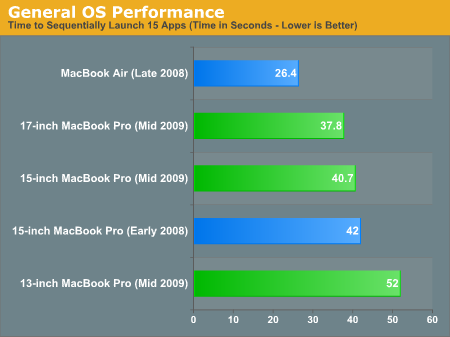
The 13-inch MacBook Pro performs the worst here by a large margin, not just because of its lowly 2.26GHz Core 2 Duo, but also because it only has 2GB of memory. The 13-inch system takes nearly 30% longer to load all of the apps because of its limited amount of memory.
The 15-inch MacBook Pro uses a 2.53GHz Core 2 Duo instead of the 2.80GHz chip in the 17-inch by default. The result is a 7% longer load time on the 15-inch system, not huge, but not insignificant. As always, I recommend getting the fastest CPU you can afford if you're planning on keeping this machine for a while.
The fastest machine here is actually the MacBook Air, because it comes with an SSD. Your best bet to improve overall system responsiveness and launch times is to get a good SSD. Even with only 2GB of memory, the current gen MacBook Air finishes the script faster than the 17-inch MacBook Pro. Paired with an Intel X25-M G2 the 15-inch MacBook Pro can run through our script in 16 seconds.
Adobe Photoshop CS4 Performance
The Retouch Artists Speed Test we use for our CPU testing under Windows also works under OS X. We're running the exact same benchmark here, basically performing a bunch of image manipulations and filters and timing the entire process.
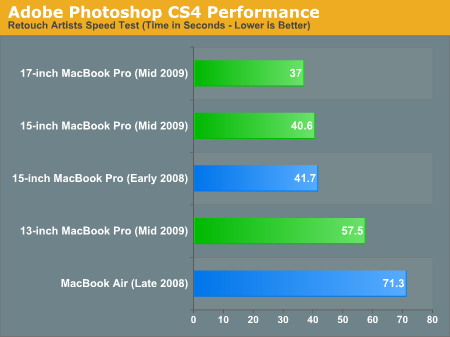
Despite limiting Photoshop to not keeping any history, the 2GB 13-inch MacBook Pro takes around 40% longer to complete the test than the 15-inch MacBook Pro. If you're planning on doing any Photoshop work you'll want to upgrade the 13-inch system to 4GB of memory.
The slower CPU in the 15-inch system penalizes it by around 10% compared to the 17-inch MacBook Pro. For any sort of real performance work, it looks like a 15-inch MacBook Pro with the 2.80GHz upgrade would be a good balance of price/performance.
As I alluded to earlier, there's not much of a performance improvement from the early 2008 MacBook Pro to the current generation. Drive speeds have improved a bit but overall performance hasn't really gone up, it's why Apple had to rely on updated looks and much better battery life to sell systems this time around. Not a bad tradeoff if you ask me, you'll see the performance improvement next year with Arrandale.
Aperture 2 RAW Import
For my Aperture test I simply timed how long it took to import 203 12MP RAW images into the library.
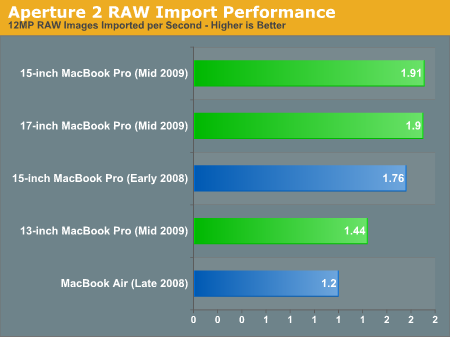
Once again, 2GB isn't enough, the 15-inch and 17-inch are indistinguishable but the 13-inch system takes much longer here.
Cinebench R10
3D rendering performance is mostly CPU bound so the 13-inch system isn't penalized by its memory limitations. Here the 2.53GHz Core 2 Duo is around 11% faster than the 2.26GHz in the 13-inch MBP. The 2.80GHz CPU is another 11% faster on top of that.
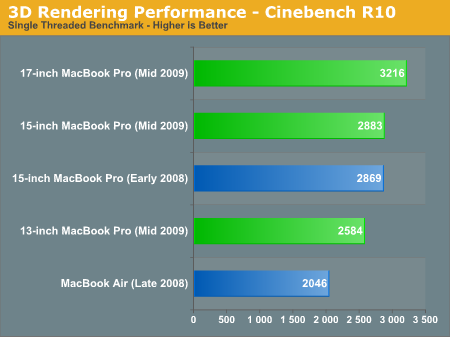
In the multithreaded bench the performance advantages are about the same, a bit closer to 12% between chips.
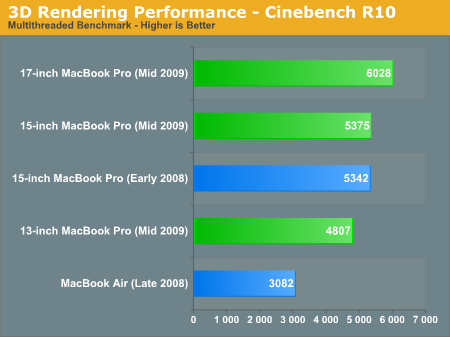
Again we see that CPU speed hasn't really improved much since early 2008, the two 15-inch systems are basically equal performers here.
Quicktime H.264 Video Encoding
Our final benchmark is more consumer focused. Here I'm taking an XviD and converting it to an iPhone-supported H.264 format.
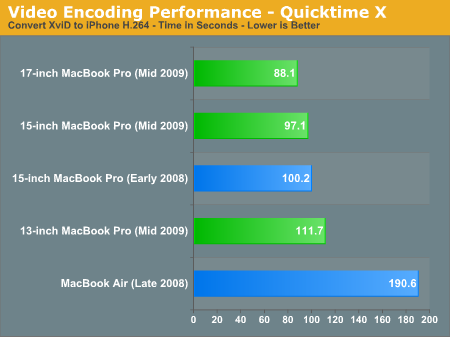
We're CPU bound here so the 13-inch system only takes 14% longer to convert our video clip than the 15-inch. The difference between the 15-inch and 17-inch is about another 10%.










115 Comments
View All Comments
marraco - Sunday, November 15, 2009 - link
Each mac is obsolete, offer lots less functionality, are MUCH slower, have the worst screens, sound, video, processor. have problems or plain incompatibility with most hardware, and 99% of useful software don't run on macs (no, once you run them on virtualized windows, you have all, and each problem of windows, -wich need too buy for extra money)-, and runs too much slower.also, macs are much harder to use, once you try to do something not basic, or find a problem (and macs are crammed with problems), the only way to solve it, is to open a text screen, and hand write LOTS of cryptycal commands.
you go to support, and they start forcing you to sign a contract agreeing to pay to apple U$S 100 or support, EVEN UNDER FIRST DAY GUARANTEE.
Then you find that those "genius bar dudes" are completely clueless...
robco - Wednesday, November 11, 2009 - link
I just upgraded to the midrange 2.66GHz 15" model. I agree that it is the sweet spot for portability and usability. I had gotten used to the 13" display on my MacBook, but the added screen real estate is nice and the weight increase is minor. The brightness provided by the LED backlight is great. The battery life is incredible, especially when using the 9400M. The build quality so far has been excellent. I can see why Apple hasn't "upgraded" the GPU yet, the 260M seems like little more than a rebranded 9600M. But it works for the few games I play on my computer these days. It does get awfully hot when using the 9600M under load.I considered switching back to a Windows machine, but couldn't find anything that was as thin and light as the MBP, or match the build quality. Those that came close tended to be higher end machines and the cost savings dropped considerably. Having brought my MacBook in to the Apple Store for service, I can say that the service is quite good.
I tried to wait for Arrandale, but couldn't hold out. I may not have the fastest notebook available, but it's fast enough for my needs.
SteveMinne - Wednesday, November 11, 2009 - link
First release of Snow Leopard nicked battery life about 40% off Leopard. Instand huge downgrade. Rounds and rounds of Apple and third party updates now have that down below 20% heading toward 15%.Your 10% testing is solid. It's just still too optimistic for this social media driven world.
The apps I have on all the time are TweetDeck (Adobe Air), Entourage, and Firefox (and by extension Flash). I run 10-15 add'l apps on and off through each day. It's these main three that hit the cpu much harder at times than when on Leopard. I have no time to isolate testing as you have but have watched them in Activity Monitor.
Should also mention I switched to 32 bit Safari months ago. So I'm reporting increased power consumption based on third party apps sitting on Snow Leopard.
Finally, I am also finally coming around to liking Snow Leopard. I've advised dozens of folks to wait and most have. Your real world experience and mine have saved a lot of folks early adoption pain.
Keep up the good work.
GeorgeH - Tuesday, November 10, 2009 - link
"I used IE8 and Windows Media Player 11 in Windows 7 while I used Safari/iTunes in OS X. The results I got were both expected and quite revealing."Absolutely expected, but thanks for redoing the test with IE and WMP anyway.
sigmatau - Wednesday, November 11, 2009 - link
Ya, very biased test. Run Windows 7 on a Mac to get benchmarks instead of running it on a PC. Good one!GeorgeH - Wednesday, November 11, 2009 - link
My comment was in reference to an earlier article where Windows battery life was measured using Safari+iTunes, nothing more.For the record, there was absolutely nothing biased about this test - a Mac IS a PC, just one with a different BIOS.
sigmatau - Wednesday, November 11, 2009 - link
Um yes it was biased. Running anything Windows on a Mac and taking benchmarks for that and comparing it to native Apple software is biased. Windows runs slower on a Mac. Apple does everything within its power to make MS products look bad. Just look at their iTunes for Windows, complete crap compared to the version that runs on Macs.darwinosx - Tuesday, November 10, 2009 - link
Really good article but I'm surprised be a few of the comments. Mostly about Flash. It's well known that Flash for the Mac sucks. But thats an Adobe issue not an Apple issue. If Flash is acting up for you then uninstall it first using Adobes uninstaller. then reinstall. Don't install over the exiting version. Not all hardware is the same as your generic PC. The motherboard isn't. It is designed by Apple and IBM engineers. Same with the battery and its controller. For generic PC parts Apple has much higher and more stringent quality control standards than Dell or HP etc. So you are much less likely to get a bad part or own that does not perform to spec. If you do have an issue then Apples support is head and shoulders above everyone else. No one else is even close in customer satisfaction. Regarding SSD's it snot like some PC's don't have issues with various makes. I'm using a Crucial 256MB SSD in my 15-inch MBP, 2.8ghz, 512MB 9600GT. Runs very well. I've had just about everything at one time or another during my 20 years in IT and this laptop is way above the pack in every category. A lot of companies these days are offering the option of Macs and every IT Architect I know of has jumped at the chance. We value quality, performance, support and stability as well as the great multi-tasking and efficient use of proc and large amounts of ram that only OS X and Linux/Unix provide. Not like that warmed over version of Windows with all the same old issues. The trackpad is incredibly useful. PC companies are starting to put larger trackpads on their laptops but nothing like what Apple has. As far as prices go you don't have to pay retail. I have a work issued MBP and my own as well. I saved about $400 buying mine over the internet instead of in a store. I had to laugh seeing prices comparison with a Dell 1555. What a cheap hunk of plastic junk. I can't tell you how many work issued Dell's have died on me over the years. About 5 or 6 years ago I had three brand new Dell laptops, top of the line business models, die on me in a single year. 3 brand new laptops croaked in one year. No wonder I have seen so many companies dump Dell and buy HP business laptops. I do like the HP W series laptops and Thinkpads are decent although not as well made with the same material quality as they once were. But I don't see anything keeping me from sticking with macs for a long time to come. The quad cores should be out soon. With 8 GB of ram and quad core you will be able to run multiple VM's as well as OS X making MBP's the most versatile laptop you can buy today.marraco - Sunday, November 15, 2009 - link
...and the sound of those macs are awful. really crap hardware.you play am mp3, and half of the instruments don't sound. those cheap speakers cannot reproduce half the frequencies.
Griswold - Wednesday, November 11, 2009 - link
Thats alot of bullshit in this wall of text. Dont they teach you apple fanboys how to structure a post?Especially the QA part on the off-the-shelf PC parts. If their QA was so great, how come they didnt avoid that shitstorm with nvidia IGPs? And thats not the only example.